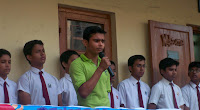 Rabindranath Tagore means too much to too many Indians for the writer of this post to encapsulate within the limited space available here all they feel for arguably the greatest poet India has ever produced. I am going to eschew the regular paeans people have a tendency to weave about their favourite literary figure. Rather, I will dwell on what the Renaissance Man means to Indians in the 21st century.
Rabindranath Tagore means too much to too many Indians for the writer of this post to encapsulate within the limited space available here all they feel for arguably the greatest poet India has ever produced. I am going to eschew the regular paeans people have a tendency to weave about their favourite literary figure. Rather, I will dwell on what the Renaissance Man means to Indians in the 21st century.  Yes, remix versions of Rabindrasangeet are available for the listening pleasure of the new generation of initiates who have resisted the influence of the man and his ideas as it has been handed down to them by parents or teachers or others belonging to a different time. Filmmakers, like Rituparno Ghosh, still dip into the literary oeuvre of the master to get material for their films. Shantiniketan is still the favourite haunt of the discerning Bengali scholar and hordes of tourists, who want to bask in the Tagorean sunshine that warms the portals of that hallowed institution. Plays, in Bengali as well as other Indian languages, based on his immortal works are still staged at the Academy of Fine Arts among other prominent theaters all over the country. And come Rabindra Jayanti and the lay man is literally haunted with images of Tagore, from youth to old age, staring severely at him from hoardings all across the city. Tagore still lives! And how!
Yes, remix versions of Rabindrasangeet are available for the listening pleasure of the new generation of initiates who have resisted the influence of the man and his ideas as it has been handed down to them by parents or teachers or others belonging to a different time. Filmmakers, like Rituparno Ghosh, still dip into the literary oeuvre of the master to get material for their films. Shantiniketan is still the favourite haunt of the discerning Bengali scholar and hordes of tourists, who want to bask in the Tagorean sunshine that warms the portals of that hallowed institution. Plays, in Bengali as well as other Indian languages, based on his immortal works are still staged at the Academy of Fine Arts among other prominent theaters all over the country. And come Rabindra Jayanti and the lay man is literally haunted with images of Tagore, from youth to old age, staring severely at him from hoardings all across the city. Tagore still lives! And how! As the city geared itself to reel with traditional jubilation on the 150th anniversary of the bard’s birth, I realized, as I drove past Rabindra Sadan early this morning, that Tagore is just around the corner, waiting to be discovered by those who are yet to make their acquaintance with him. The sound of Tagore’s “Tomar Holo Shuru” floated in the air making the entire atmosphere radiant and blissful.
 Rabindra Jayanti was celebrated by The Anthonian Literary Club at St. Anthony’s High School with the traditional homage the institution pays to the Nobel Laureate every year. A short biography of the poet was read, followed by the garlanding of the bard’s portrait by the Headmaster, Fr. Devraj Fernandes. A recitation of “Where the mind is without fear” was followed by a Rabindrasangeet sung by the teachers of the school.
Rabindra Jayanti was celebrated by The Anthonian Literary Club at St. Anthony’s High School with the traditional homage the institution pays to the Nobel Laureate every year. A short biography of the poet was read, followed by the garlanding of the bard’s portrait by the Headmaster, Fr. Devraj Fernandes. A recitation of “Where the mind is without fear” was followed by a Rabindrasangeet sung by the teachers of the school. The programme ended but the memory of it lingered on and as I came to write this blog post I could not help but be drawn towards Satyajit Ray’s documentary of Rabindranath Tagore. It is the auteur’s homage to the bard - one master’s tribute to another.
Satyajit Ray's Documentary on Rabindranath Tagore




Very lucid writing with a personal touch. Liked it very much.
ReplyDeleteNice work! Good idea. Kudos.
ReplyDeleteEven the write-ups are cool.